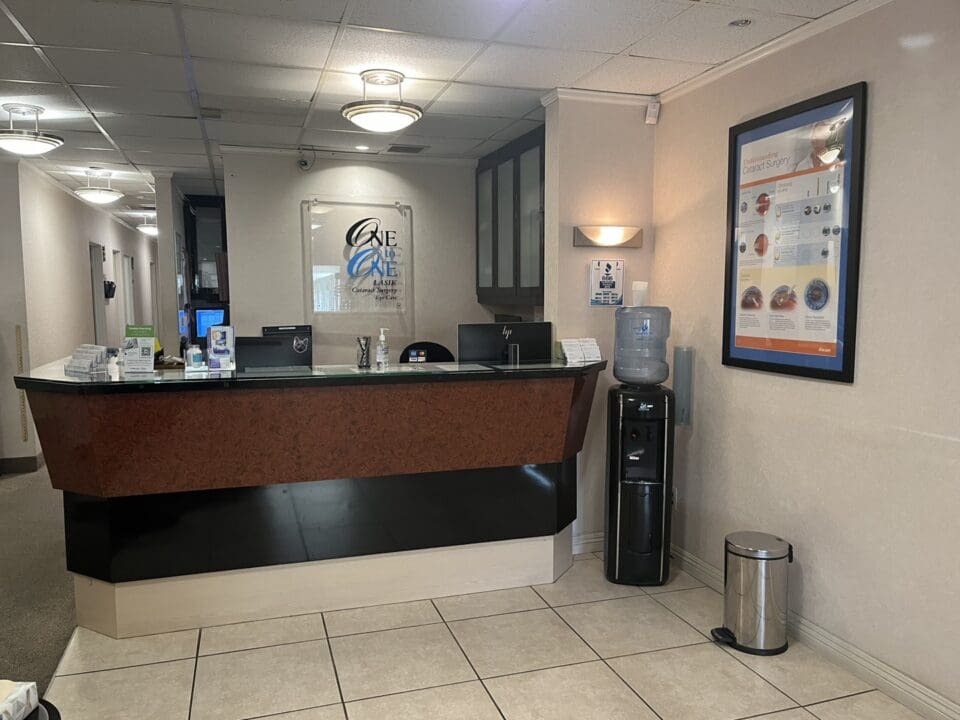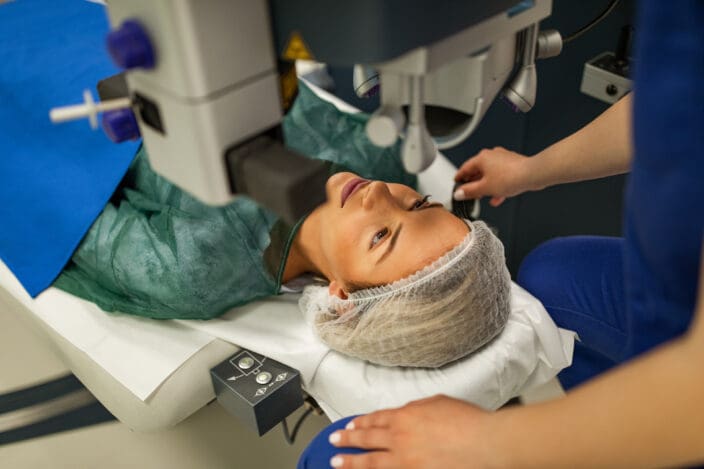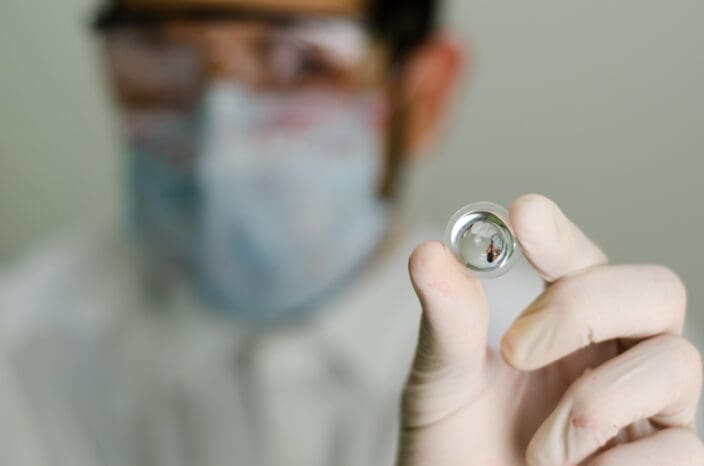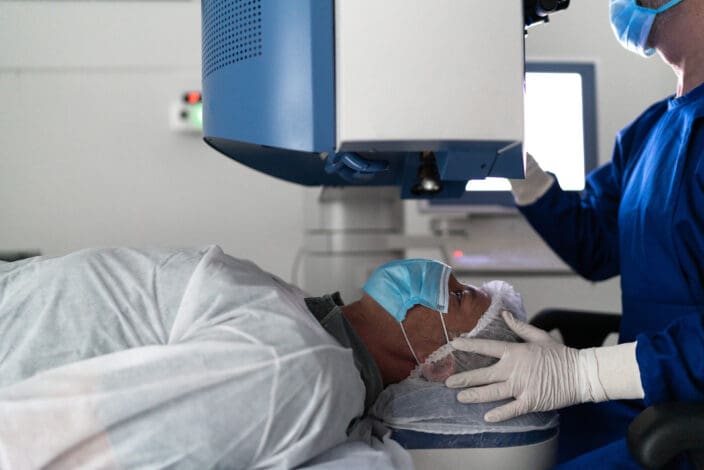
One to One LASIK
LASIK in San Diego - Clairemont
Discover personalized eye care at One to One of San Diego, in Clairemont / Pacific Beach.
Our eye clinic specializes in LASIK eye surgery and Cataract surgery, conveniently located in the Clairemont / Pacific Beach community of San Diego. Our dedicated team believes in taking the time to understand your needs, offering the latest technology and customized treatment options. Whether you’re considering Cataract Surgery or LASIK Eye Surgery, we’re here to provide comprehensive care tailored to your vision goals. LASIK eye surgery can correct various refractive errors, including myopia (nearsightedness), hyperopia (farsightedness), and astigmatism.
At One to One of San Diego, in Clairemont / Pacific Beach, we’re committed to delivering exceptional results in a welcoming environment. With a focus on individualized attention and state-of-the-art technology, we strive to make your journey to clearer vision a seamless and rewarding experience. Trust our expertise and dedication to transform your vision and enhance your quality of life.
What’s next? First, explore our vision education library to learn answers to common questions such as LASIK Myths, Am I a Candidate for LASIK, How Long Does LASIK Take, LASIK recovery time and more. Then, find an eye clinic location near you to schedule a consultation and take the first step toward clearer vision and a brighter future.
Not sure if LASIK is right for you?

99% SUCCESS RATE 99% of NVISION patients see 20/20 or better after LASIK

RAPID RECOVERY Resume your normal activities in 24 hours

COMFORT-FOCUSED LASIK is virtually painless and completed in minutes
One to One LASIK
3737 Moraga Avenue, Suite A-105San Diego, CA 92117
Mon - Fri: 7:45 AM - 4:30 PM
Saturday: Closed
Sunday: Closed
Hurry, Offer Ends Soon
Book now for $1,000 off LASIK* + Enjoy Easy and Fast LASIK Financing**
Vision Correction Procedures in Clairemont/Pacific Beach
Today's life-changing procedures make it possible to improve your vision to 20/20—or better.
LASIK Eye Surgery
LASIK eye surgery is a safe, highly effective solution to correct vision and eliminate the need for glasses or contacts. At NVISION, our expert surgeons use state-of-the-art technology and advanced techniques to deliver exceptional results and have you back to your routine quickly.

EVO ICL™ (Implantable Collamer Lens)
Say goodbye to glasses and contacts with EVO ICL™! This advanced procedure is an excellent option for patients who aren’t LASIK candidates. By placing a biocompatible lens in your eye—without removing the natural lens—EVO ICL™ corrects nearsightedness and astigmatism, providing clear, long-lasting vision.

Cataract Surgery
Cloudy vision holding you back? Our advanced cataract surgery, featuring laser-assisted technology and lifestyle lenses, can restore your sight and help you enjoy life’s moments clearly again.

iDose® TR Glaucoma Treatment
iDose® TR is a micro-sized implant that provides a continuous release of glaucoma medication directly inside your eye. This ensures 24/7 eye pressure control – it’s so effective that 8 out of 10 patients don’t need glaucoma drops anymore.

Other Procedures
Contoura® Vision LASIK
What is Contoura® Vision LASIK?
Contoura® Vision LASIK is an advanced form of LASIK eye surgery that utilizes topography-guided technology to tailor the laser treatment to the unique characteristics of an individual’s cornea. This technology aims to provide a more personalized and precise correction of refractive errors, including nearsightedness, farsightedness, and astigmatism. Contoura® Vision creates a highly precise and accurate map of a patient’s eyes measuring up to 22,000 unique elevation points on each eye.
Key features of Contoura® Vision LASIK include:
- Topography-Guided Treatment:
Contoura® Vision LASIK utilizes detailed corneal mapping or corneal topography to create a highly customized treatment plan. This map captures thousands of data points on the cornea, allowing for a more precise analysis of its shape and irregularities. - Personalized Correction:
The topography-guided technology enables the laser to precisely reshape the cornea based on the unique imperfections detected in the corneal map. This personalized approach aims to address higher-order aberrations, improving not only traditional refractive errors but also the overall quality of vision. - Reduced Glare and Halos:
Contoura® Vision LASIK is designed to reduce the occurrence of visual disturbances such as glare and halos, which can be associated with certain refractive errors. The customized treatment may result in improved night vision and reduced sensitivity to light. - Potential for Better Visual Outcomes:
The goal of Contoura® Vision LASIK is to achieve superior visual outcomes by optimizing the correction based on the individual characteristics of the patient’s cornea.
It’s important to note that the availability of Contoura® Vision LASIK may vary, and not all LASIK centers offer this specific technology. If you are considering LASIK surgery and are interested in Contoura® Vision LASIK, it’s recommended to consult with an experienced refractive surgeon or LASIK eye doctor who can assess your candidacy and discuss the available options for personalized laser vision correction.
PRK Surgery (Photorefractive Keratectomy)
What is PRK Surgery?
PRK Surgery (Photorefractive Keratectomy) is a type of laser eye surgery that is used to correct refractive errors such as nearsightedness (myopia), farsightedness (hyperopia), and astigmatism. PRK is an alternative to LASIK eye surgery and is particularly suitable for individuals who may not be candidates for LASIK due to certain corneal characteristics.
Overview of the PRK surgery process:
- Corneal Epithelium Removal:
- In PRK, the surgeon begins by removing the thin outer layer of the cornea called the epithelium. This can be done using an alcohol solution, a special brush, or a laser.
- Laser Reshaping of the Cornea:
- Once the epithelium is removed, a laser is used to precisely reshape the cornea. The laser ablates or removes microscopic amounts of corneal tissue based on the patient’s refractive error. The goal is to correct the curvature of the cornea and improve the focus of light on the retina.
- Healing Process:
- Unlike LASIK, where a corneal flap is created, PRK does not involve creating a flap. Instead, the corneal surface is allowed to regenerate naturally. The healing process involves the growth of new epithelial cells over the treated area.
- Post-operative Care:
- Following PRK surgery, patients are given medicated eye drops to aid in the healing process and prevent infection. Recovery may take a bit longer compared to LASIK, and patients may experience temporary discomfort during the initial days.
Key considerations for PRK surgery include:
- Corneal Thickness: PRK may be a suitable option for individuals with thinner corneas who may not be ideal candidates for LASIK.
- Occupational Considerations: PRK may be recommended for individuals with occupations or lifestyles that carry a risk of corneal injury, as it eliminates the creation of a corneal flap.
- Healing Time: The initial visual recovery may take longer with PRK compared to LASIK. Patients typically experience optimal vision several weeks after the procedure.
PRK is a well-established and effective procedure for vision correction, and its suitability depends on individual factors. It’s important to consult with an experienced refractive surgeon or eye care professional to determine the most appropriate laser eye surgery option based on your eye health and lifestyle.
Dry Eye Treatment
Dry eye is an irritating, painful, and common condition in which the eye fails to properly produce quality tears. When left untreated, it may lead to ulcers and scars on the cornea.
Depending on the severity of your condition, there are a variety of treatments to relieve dry eyes.
Refractive Lens Exchange (RLE)
Refractive lens exchange (RLE), is when a clear lens is implanted to replace your eye’s natural lens to correct your vision.
This procedure is often used for pre-cataract patients, as a preventative vision correction solution. Refractive lens exchange (RLE) can also correct nearsightedness, farsightedness, and astigmatism.
Corneal Collagen Crosslinking (CXL)
Keratoconus is a progressive disease of the cornea. With collagen cross-linking (CXL), you can halt the progression of keratoconus by strengthening your cornea.
Intacs® Corneal Implants for Keratoconus
The surgical implantation of intracorneal ring segments or Intacs® is a minimally invasive surgical option to improve the corneal shape in patients with keratoconus.
Intacs® are surgically inserted into a thin channel created by a femtosecond laser in the periphery of the cornea. Intacs® is also known as surgical implantation of intracorneal ring segments.
Lifestyle Lenses
Lifestyle lenses are a premium lens option that offers a more functional range of vision, and are designed to reduce the need for distance and reading glasses.
We offer the latest and most advanced lifestyle lens on the market.
Pterygium Surgery
Pterygium surgery is performed under topical anesthesia on an outpatient basis.
Comprehensive Ophthalmology
Comprehensive ophthalmology handles general eye exams and common conditions such as cataracts. macular degeneration, refractive errors, glaucoma, and more. The service also provides screening examinations to help detect potential illnesses.
Monovision LASIK
Monovision lasik can treat presbyopia. One eye would remain slightly nearsighted while correcting your other eye for distance vision. With both eyes open, you’ll experience clear and comfortable vision both near and far.
Lid Biopsy
An eyelid biopsy is a crucial diagnostic procedure utilized by ophthalmologists and dermatologists to accurately identify and effectively manage various abnormalities and tumors affecting the eyelid. By extracting a small tissue sample from the affected area, this procedure enables healthcare providers to conduct thorough examinations under a microscope, pinpointing the specific nature of the growth or lesion present.
Glaucoma Surgery
Glaucoma eye surgery involves using a microscopic stent to drain fluid that could harm the optic nerve. This procedure is minimally invasive.
Macular Degeneration Treatment
There’s no cure, but treatment for age-related macular degeneration (AMD) can slow the progression of the disease and prevent serious vision loss.
Cornea Transplantation
A corneal transplant, also known as keratoplasty, is a surgical procedure aimed at replacing a damaged or diseased cornea—the transparent outer layer of the eye—with healthy corneal tissue from a donor. This procedure is typically performed to restore vision in individuals with corneal conditions such as keratoconus, corneal scarring, corneal dystrophies, or corneal ulcers that have not responded to other treatments.
Chalazion Surgery
Chalazion surgery, also known as chalazion excision or chalazion removal, is a surgical procedure performed to treat a chalazion—a small, non-infectious bump or cyst that develops on the eyelid.
Chalazion surgery is usually performed as an outpatient procedure, meaning the patient can go home the same day. After surgery, patients are typically advised to apply warm compresses to the eyelid and to avoid rubbing or touching the area. Antibiotic ointment or drops may also be prescribed to prevent infection.
YAG and SLT Lasers
YAG (Yttrium-Aluminum-Garnet) and SLT (Selective Laser Trabeculoplasty) lasers are both important tools used in eye clinics for different purposes.
YAG laser: YAG lasers are commonly used in eye clinics for posterior capsulotomy procedures following cataract surgery. Sometimes, after cataract surgery, the capsule behind the implanted artificial lens becomes cloudy, causing vision problems. A YAG laser is used to create a small opening in this cloudy capsule, allowing light to pass through and restoring clear vision. YAG lasers are also used in the treatment of certain types of glaucoma by creating small openings in the drainage system of the eye to improve the flow of aqueous humor and reduce intraocular pressure.
SLT laser: SLT lasers are primarily used in the treatment of open-angle glaucoma. Unlike traditional laser trabeculoplasty, SLT targets specific cells in the trabecular meshwork of the eye, using short pulses of low energy. This selective approach minimizes damage to surrounding tissue and reduces the risk of complications. SLT laser treatment helps to improve the drainage of aqueous humor from the eye, thereby lowering intraocular pressure and slowing the progression of glaucoma.
Both YAG and SLT lasers play vital roles in the management of various eye conditions, providing effective and minimally invasive treatment options for patients. However, their specific applications differ, with YAG lasers primarily used for posterior capsulotomy and certain glaucoma treatments, while SLT lasers are specifically designed for the treatment of open-angle glaucoma.
We Accept Insurance
At NVISION Eye Centers, we strive to make managing your care as easy as possible. In addition to working with many insurance providers, we offer a convenient online payment option for your bills. Click here to pay your bill online.
Below, you’ll find a list of the insurance companies we currently accept at this location. If your provider is not listed, please give us a call—NVISION frequently adds new insurance companies and offers many out-of-network options.
- Aetna
- Cigna
- Medicare
- VSP
- GEHA
- MultiPlan
- Anthem BCBS
- Avanta IPA
- Blue Shield CA
- Eye Med
- HealthNet of CA
- Samba
- Tricare West
- United HealthCare
Surgeons at One to One LASIK

Angelique J. Pillar, MD is a fellowship trained and board certified ophthalmologist specializing in cataract, cornea, and refractive surgery.
Your Eye Clinic for Cataract Surgery & LASIK in San Diego
At NVISION® Eye Centers, we provide life-changing results, an exceptional experience, and a lifetime commitment to your LASIK vision correction.
- Industry-leading eye doctors and vision outcomes with more than 2 million successful procedures
- The most advanced laser and diagnostic technology available
- Financing available – no down payment, zero or low interest, low monthly payments
- Free LASIK consultations
- Use your FSA/HSA balance toward LASIK before it expires in December
Location Information – San Diego Eye Clinic
One to One LASIK, an NVISION Eye Center
3737 Moraga Ave Suite A-105, San Diego, CA 92117
(858) 346-5566

